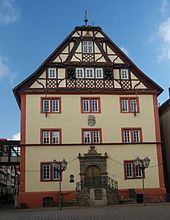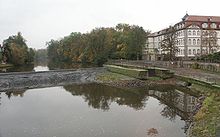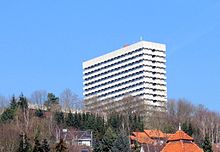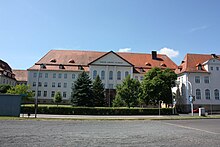Rotenburg on the Fulda
| coat of arms | Germany map | |
|---|---|---|
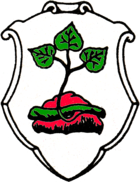
|
Coordinates: 51 ° 0 ' N , 9 ° 44' E |
|
| Basic data | ||
| State : | Hesse | |
| Administrative region : | kassel | |
| County : | Hersfeld-Rotenburg | |
| Height : | 183 m above sea level NHN | |
| Area : | 79.84 km 2 | |
| Residents: | 14,555 (Dec. 31, 2019) | |
| Population density : | 182 inhabitants per km 2 | |
| Postal code : | 36199 | |
| Area code : | 06623 | |
| License plate : | HEF, ROF | |
| Community key : | 06 6 32 018 | |
| LOCODE : | DE RBF | |
| NUTS : | DE733 | |
| City structure: | 8 districts | |
City administration address : |
Marktplatz 15 36199 Rotenburg an der Fulda |
|
| Website : | ||
| Mayor : | Christian Grunwald ( CDU ) | |
| Location of the city of Rotenburg an der Fulda in the district of Hersfeld-Rotenburg | ||
Rotenburg an der Fulda (officially Rotenburg ad Fulda ) is a small town in northeastern Hesse and is located on the Fulda River in the Hersfeld-Rotenburg district .
geography
Geographical location
The city is located south of the Stölzinger Mountains in the narrowest area of the Fulda valley . The lowest point is 180 m above sea level. NN in the area of the two Fulda bridges ("Old Fulda Bridge" and "Bridge of the City Partnerships"). The highest point is 548.7 m above sea level. NN high Alheimer , which lies on the boundary between the city and the municipality of Alheim .
Nearby cities are Bebra about 6 km southeast and Bad Hersfeld about 16 km in the south. The next larger cities are Kassel, about 50 km to the north, and Fulda, about 60 km to the south .
Neighboring communities
The neighboring communities, starting from the north, are Alheim , Spangenberg , Cornberg , Bebra and Ludwigsau . On the so-called " Stölzinger Höhe ", in the northeast above the Dankerode district, Rotenburg shares a border with the town of Waldkappel .
City structure
The core city lies on both sides of the Fulda, connected by four bridges. Of these, the Twinning Bridge is the only fully-fledged road bridge. The old town also consists of two parts, only connected by the Alte Fuldabrücke near the castle , which is used for cyclists, pedestrians and residents. The other two bridges are on the outskirts and are purely pedestrian bridges. The districts of Lispenhausen , Braach , Schwarzenhasel , Erkshausen , Seifertshausen , Dankerode , Atzelrode (with Gut Alte Teich and Wüstefeld) and Mündershausen belong to Rotenburg an der Fulda .
history
In the nomenclature of goods Breviarium Sancti Lulli of the monastery Hersfeld of 769 villages (now neighborhoods) Braach, Lispenhausen and Breitingen desolate lying (memorial stone in the area of allotment gardens, tennis courts) were mentioned for the first time. These villages consisted of six manors and 90 acres of land.
The Gisonen were bailiffs of the Hersfeld Abbey . They built their first security castle in the Fulda valley when they succeeded in taking possession of the bailiwick. A settlement was built around this castle. The Thuringian Landgraves , who came into the possession of the Vogtei through inheritance after the Gisonen, built the Rodenberg Castle on the Alter Turm mountain , which is still visible today in ruins and from whose name the city name was probably derived.
The settlement on the left Fuldaufer, today's old town, was first mentioned as a city in 1248 and after the Hessian-Thuringian War of Succession in 1264 the city belonged to the Landgraviate of Hesse . The old Talburg, on the side of the old town, is said to have been demolished after 1423. The first Rotenburg Castle was built in 1470 . A big fire in 1478 destroyed the old town and the recently built castle. From 1627 to 1834 Rotenburg was the seat of the landgrave's branch line Hessen-Rotenburg , the so-called Rotenburger Quart .

In 1615 57 houses burned down in Braach, and during the Thirty Years War in 1637 the town and the town hall were burned down by soldiers from the Isolani regiment .
In March 1882 the volunteer fire brigade was founded as an association; In 1900 it was given a fire station with a hose tower near the Fulda.
During the Second World War was Rotenburg location of a POW camp for officers, the Oflag IX A / Z . A troop leader school for the Reich Labor Service was set up in the former Landgrave's Palace.
Rotenburg was the district town of the old district of Rotenburg until 1972 ; since 1972 it belongs to the district of Hersfeld-Rotenburg . In 2003, the city gained fame through the criminal case of Armin Meiwes .
In 2004 the city received a silver medal in the national competition “ Our city is in bloom ” and in the following year 2005 a gold medal and a special prize for the design of the renatured landscape in the Fulda floodplain .
In August 2007, the city's volunteer fire brigade organized the 20th Hessian Fire Brigade Day on the occasion of the 125th anniversary of its founding.
Religions
The area of the city of Rotenburg today belongs to the Evangelical Church of Kurhessen-Waldeck and the largely congruent Catholic diocese of Fulda . Landgrave Philip the Magnanimous introduced the Reformation in the Landgraviate of Hesse after the Homberg Synod in 1526 , and the city has been mostly Protestant since then. Rotenburg is the seat of the Evangelical Church District Rotenburg.
Evangelical:
There are ten Protestant parishes in the city.
Catholic:
The two Catholic churches are:
- "Christ Redeemer" in Mündershäuser Strasse 1
- "To the Sorrowful Mother of God" at Schützenweg 4 in the Lispenhausen district
who belong to the parish of St. Franziskus Bebra-Rotenburg in the diocese of Fulda.
New Apostolic:
There is also a New Apostolic congregation.
Incorporations
On December 31, 1971, the formerly independent communities Atzelrode (with the Wüstefeld residential area), Braach (with the Grundmühle) and Mündershausen were incorporated as part of the regional reform in Hesse . On August 1, 1972, Dankerode, Erkshausen, Lispenhausen, Schwarzenhasel and Seifertshausen were added. All of these former communities are now districts of Rotenburg an der Fulda.
politics
City Council
The local elections on March 6, 2016 produced the following results, compared to previous local elections:
| Parties and constituencies |
% 2016 |
Seats 2016 |
% 2011 |
Seats 2011 |
% 2006 |
Seats 2006 |
% 2001 |
Seats 2001 |
||
|---|---|---|---|---|---|---|---|---|---|---|
| SPD | Social Democratic Party of Germany | 35.6 | 11 | 45.8 | 17th | 51.8 | 19th | 50.4 | 19th | |
| CDU | Christian Democratic Union of Germany | 42.4 | 13 | 38.6 | 14th | 35.9 | 13 | 37.7 | 14th | |
| UBR | Independent citizens of Rotenburg | 18.8 | 6th | 15.6 | 6th | 10.3 | 4th | 9.3 | 3 | |
| FDP | Free Democratic Party | 3.2 | 1 | - | - | 2.0 | 1 | 2.5 | 1 | |
| total | 100.0 | 31 | 100.0 | 37 | 100.0 | 37 | 100.0 | 37 | ||
| Voter turnout in% | 49.7 | 49.6 | 48.2 | 56.2 | ||||||
mayor
According to the Hessian municipal constitution, the mayor is chairman of the magistrate , which in the city of Rotenburg includes eight voluntary councilors in addition to the mayor . Christian Grunwald (CDU) was elected as the new mayor on September 25, 2011 with 59.5% of the vote. He replaced the long-time mayor Manfred Fehr (SPD).
On September 24, 2017, Christian Grunwald - the only candidate - was re-elected for a further term.
coat of arms
Blazon : "In silver a red three-mountain , on it a horizontal green branch, from which a curved green branch with three linden leaves grows." Meaning: The coat of arms dates from the early 17th century. The mountain stands for the Rotenberg, on which a castle stood. The city takes its name from this. The linden branch comes from older guild seals on which a clover leaf and a star were depicted. This gave rise to the linden branch, which was incorporated into the city arms. It thus belongs to the North Hessian cloverleaf family of coat of arms like Kassel and Felsberg. The first representation of the current form can be found in the knight's hall , which was demolished at the end of the 18th century. See Wilhelm Wessel 1623: "Follow the coats of arms of all cities in principalities and graffships of the princes of Hesse as they can be found in Rotenbergk in the Princely Castle / in the great hall." The first images on the medieval town seal show a saint carrying a palm branch a city gate. It is probably the city patron St. James the Elder .
| The motto is: |
| Rotenburg an der Fuld 'the city, |
| has three green leaves on the shield. |
| The mountain is red, the shield is white |
| who is green, who lives honorably with diligence. |
Town twinning
- Argentan (France) since 1976
- Gedling (Great Britain) since 1978
- Rothenburg (Switzerland)
We have friendly relationships with the following cities :
- Rotenburg (Wümme) ,
- Rothenburg ob der Tauber ,
- Rothenburg (Saale) ,
- Rothenburg / OL and
- Czerwieńsk in Poland (formerly Rothenburg on the Oder )
Culture and sights
Museums
- Rotenburg District Home Museum, Outer Castle Courtyard
- Doll and Toy Museum, Bürgerstrasse 1
- Museum of Contemporary Art, Culture and Caricature (muzkkka), closed on December 31, 2011
- Jewish Museum in the former mikveh , memorial and meeting place, Brauhausstraße 2
Buildings and sights
The main attractions of the city are:
- The Rotenburg castle in the style of Renaissance , rebuilt in the years 1570-1607, rebuilt around the year 1790, including preserved outbuildings and the castle park, since 1953 state finance school Hesse .
- The three-storey town hall built between 1597 and 1598 instead of an older building. It was almost completely burned down in the Thirty Years' War , in the so-called "Croatian Year" 1637. Then the half-timbered gable was built. The Renaissance portal with the cloverleaf coat of arms has been preserved (dated 1598) and is still visible today with a two-flight baroque staircase.
Churches
- The parish church of St. Jakobi named after the city's patron saint
- The also Protestant parish church (former collegiate church "St. Elisabeth and Marien") in the Neustadt was built from 1371 (inscription on the southern tower) in place of the Elisabeth Hospital. The first construction phase, which lasted until 1379, also included the two choir flank towers (up to the height of the eaves of the nave) and the base walls of the first two nave bays. The three-aisled and three-bay church hall (originally 5 bays) was built between 1484 and 1501. In 1651, the crypt of Landgrave Hermann von Hessen and his second wife Juliane Kunigunde von Anhalt-Zerbst was built into the ground floor of the north tower . Both the semicircular apse in the west, the three-sided east end, the raised south tower and the vaults and pillars in the church hall belong to the neo-Gothic style and were built between 1822 and 1892. The old Gothic west portal is built into the north side of the nave.
additional
- On the Alter Turm mountain ( 418.1 m above sea level ), the ruins of Rodenberg Castle (built around 1150 by the Thuringian landgraves ) are hidden in the forest .
- In the vicinity of the Fulda bridge is a historic weir system with a lock from the 16th and 17th centuries (built at the instigation of Landgrave Moritz von Hessen-Kassel). There is also the hydroelectric power station with three turbines (including a museum piece that is over 100 years old). Part of the building stands on the remains of the Herrenmühle, which was built by Landgrave Moritz in 1612 and burned to the ground in 1923.
- The mikvah , the ritual immersion bath of the former Jewish community, has been archaeologically secured and has been a Jewish museum with a memorial and meeting place since 2006.
- In the area of the old town, parts of the medieval city wall from the 12th and 13th centuries with two round towers have been preserved.
- In the city center there are interesting stone and half-timbered buildings with dwarfs and some still preserved historical garden houses.
- There are also some historic churches and traditional Hessian Wilder Mann half-timbered buildings in the districts :
- Building and plant of the Grundmühle in Braach
- The last water-powered mill in Erkshausen
- Worth seeing moated castle Schwarzenhasel with 3/4 moat in Schwarzenhasel im Haselgrund, patronage and residential house
- Moated castle in Lispenhausen , today a residential building
- Alheimer mountain height with the Alheimer tower as a lookout point
- Hofgut Wüstefeld with a former sheepfold and Hofgut Dankerode with horse breeding
Monuments
- Since May 25, 2010, fourteen stumbling blocks have been remembering Rotenburg Jews who were victims of the Holocaust . On May 27, 2011, another 29 stumbling blocks were laid.
- In addition to Homberg (Efze), Rotenburg owns a number of sculptures by the Hessian sculptor Ewald Rumpf , including the group “Tratsch der Marktweiber” on the market square, “The Diakonisse” with her dachshund in front of the Jakobikirche, the “Shepherd boy with goat” on the city wall and the “The two boys” on the Neustadt side of the old Fulda bridge.
- Building in Rotenburg
Uncovering the mikveh in Rotenburg (with Thea Altaras in June 2003)
Regular events
- Homeland and beach festival (every year on the first weekend in July)
- Historic Christmas market on the Rotenburg market square and the adjacent alleys (from the beginning of December for 16 days) with one of the highest Christmas pyramids in Germany (16.16 m)
- Cuckoo market in the Rotenburg district of Braach (North Hessian art, craft and farmers market, which takes place every last weekend in May to October)
additional
Since October 2011 the radio crime scene produced by the Hessischer Rundfunk has been playing in Rotenburg an der Fulda.
Economy and Infrastructure
The cardiovascular center (HKZ) , located on a south-facing slope above the city, is of particular importance for the city and the whole surrounding area .
As of January 2006, 4,188 people are employed in the city. Of these, the manufacturing industry offers 989 jobs, 2,143 employees are employed in the service sector, 367 employees in trade, 80 employees in the agriculture / forestry sector and 609 employees in all other sectors. There are 1,325 beds designated for tourism .
Established businesses
- RMW Rotenburger Metallwerke GmbH, now Neumayer Tekfor GmbH
- C. Brühl general partner Textilwerk Rotenburg Verwaltungsgesellschaft mbH (textile specialist trousers, shirts and jackets)
- HKZ GmbH & Co. KG, personally liable partner: HKZ Verwaltungs GmbH - " Cardiovascular Center Rotenburg ad Fulda "
traffic
Rotenburg is on federal highway 83 .
The former Rotenburg an der Fulda train station is on the Bebra – Baunatal – Guntershausen railway line and is now just one stop . The station building from 1847/48 was designed by Julius Eugen Ruhl .
Bike trails
The following cycle paths lead through the municipality :
- The Hessian Radfernweg R1 (Fulda-Radweg) leads over 250 km from the heights of the Rhön along the Fulda to Bad Karlshafen on the Weser .
- The Hessian long-distance cycle route R5 (North Hesse route Eder-Fulda-Werra) leads over 220 km from Willingen in the Upland along the southern shore of the Edersee , via Homberg (Efze) and Rotenburg an der Fulda to Wanfried an der Werra .
- The Hessian long-distance cycle route R7 (from the Lahn to the Werra) connects Werra and Taunus over 215 km through the Vogelsberg.
- The D-Route 9 (Weser-Romantic Road) leads from the North Sea via Bremen, Kassel, Fulda and the Taubertal to Füssen in Allgäu (1,197 km).
media
The daily newspaper Hessische / Niedersächsische Allgemeine (HNA) with the local section Rotenburg / Bebra appears from Monday to Saturday . On Wednesdays and Sundays, the free advertising paper “Kreisanzeiger” appears.
State institutions
- Until its dissolution in March 2006, the 52 armored infantry battalion was stationed in the Alheimer barracks at Dickenrücker Strasse 16. From July 2006, the newly established command support battalion (FüUstgBtl) 286 was located there. In addition, there was the 6th Company of the Feldjäger Battalion 251 , which had previously been stationed in Schwalmstadt. The FüUstgBtl 286 belonged to the Command Support Regiment 28 in Mechernich and was part of the Armed Forces Base (SKB) of the Bundeswehr. On October 26, 2011 it was announced that after a long discussion and a renovation in the mid double-digit million range, the Bundeswehr site in Rotenburg ad Fulda would be closed. The site was officially closed on September 16, 2014; the last soldiers of the Feldjägerkompanie left the barracks in February 2016. Since autumn 2015, the former barracks has served as a branch of the Hessian initial reception facility for refugees.
- Rotenburg study center : State Finance School Hesse , Hessian University for Finance and Justice of the State of Hesse
- District Court Rotenburg an der Fulda (until December 31, 2011)
- Hessen Mobil's training and further education center - road and traffic management
- BKK Academy - training center in the field of statutory health insurance
- Rotenburg ad Fulda road maintenance depot
- Hersfeld-Rotenburg tax office - Rotenburg ad Fulda administrative office
education
- There are ten schools in the city, including the Jakob-Grimm-Schule , which operates as an additive comprehensive school with an upper level.
- As a training center, the BKK Akademie conducts training, advanced and advanced training seminars in the field of statutory health insurance for health insurance companies and interested customers.
- The future tax officers of the State of Hesse are trained in the castle .
Sporting events
The following sporting events take place regularly in Rotenburg an der Fulda:
- Rotenburger Strandfestlauf (distances: Bambini run 650 m; school run 1.3 km; individual run 5 and 10 km; Nordic walking 5 km; team run 5 km; relay run 10 km)
- Rotenburger Ostervolkslauf (distances: 0.5 km; 1 km; 5 km; 10 km; 18 km)
- Red Castle Run (distances: children's and family circuit approx. 4 km; VR bank association circuit approx. 8 km; knight circuit approx. 16 km)
Personalities
sons and daughters of the town
- Bernhard Christoph Faust (1755–1842), doctor, researcher and architectural theorist. A street in the old town and the sports hall of the Jakob-Grimm-Schule bear his name, 2010 erection of a bust in front of the district hospital (Borngasse)
- Philipp Noll (1742–1808), master mason and church builder in the region (Oberellenbach 1778, Baumbach and Seifertshausen around 1800). A street on the old field bears his name
- Christian Carl Wenderoth (1777–1860), head of the school, pastor and Metropolitan in Rotenburg and pastor in Lispenhausen, since 1828 Consistorialrat, in 1849 made an honorary citizen of the city
- Wilhelm Eduard Hyppolite (1799–1878), tobacco manufacturer and member of the Hessian state parliament
- Eduard Wiegand (1815–1877), liberal member of the Electorate of Hesse
- Friedrich Bertelsmann (1817–1897), typesetter and book printer; Founder and editor of the publishing house "Rotenburger Kreisblatt", later Rotenburger Tageblatt
- Chlodwig zu Hohenlohe-Schillingsfürst (1819–1901), Chancellor 1894–1900
- Gustav Adolf zu Hohenlohe-Schillingsfürst (1823-1896), German cardinal to the curia
- Franz Vetter (1824–1896), electoral court gardener, from 1891 royal Prussian court gardener in Sanssouci
- Elise zu Salm-Horstmar (1831–1920), writer
- Franz König (1832–1910), country doctor in Homberg / Efze, hospital doctor in Hanau, surgeon in Rostock, Göttingen and Berlin
- Joseph Wertheim (1834–1899), industrialist and founder of the German sewing machine factory
- Heinrich Bechstein (1841–1912), organ builder
- Hermann Gelder (1866–1947), German pharmacist, pharmacy historian and graphic collector
- Moritz Katzenstein (1872–1932), professor of surgery; a street in the Jewish cemetery bears his name, a bust erected in December 2011 in front of the Im Zwickel birthplace
- Leopold Neuhaus (1879–1954), rabbi in Frankfurt am Main
- Günther Knecht (1909–1995), administrative lawyer, police director in Neuss
- Alfred G. Fischer (1920–2017), German-American geologist
- Erich Storz (1927–2016), musician and music producer
- Manfred Gruber (* 1951), painter, graphic artist and set designer
- Michael Mauer (* 1962), automobile designer, head of Porsche design
- Annette Kurschus (* 1963), President of the Evangelical Church of Westphalia
- Timo Hebeler (* 1974), legal scholar
- Melanie Lahmer (* 1974), German author
- Stefan Neugebauer (* 1975), chef, awarded one star in the Michelin Guide
- Mareike Morr (* 1977), mezzo-soprano
- Annika Becker (* 1981), athlete
- Fabian Bäcker (* 1990), soccer player
Personalities who have worked on site
- Friedrich Lucaè (1644–1708), pastor and author of the chronicle “The noble jewel on the Hessian crown - Amt Rotenburg”, court preacher in Kassel (from 1676), Metropolitan in Spangenberg (from 1694), senior pastor of the Jakobi Church in Rotenburg the Fulda (from 1696)
- August Vilmar (1800–1868), pastor and teacher in Rotenburg (1824–1833), professor at Marburg University; Street name: Vilmarstraße as the junction at Am Alten Feld in Rotenburg an der Fulda
- Jakob Wilhelm Georg Vilmar (* 1804 in Solz; † 1884 in Melsungen ), pastor of the Hessian Renitenz , pastor in Rotenburg (1830-1851), Metropolitan in Melsungen; Street name: Vilmarstraße as the junction at Am Alten Feld in Rotenburg an der Fulda
- Heinrich Eisenach (1814–1891), natural scientist, zoologist and botanist active in Rotenburg as district physician and medical adviser
- Alfred Klauhold (1818–1890), public prosecutor at the higher court
- Johannes Gelder , traceable since 1855, master brewer, owner of a lager brewery; City councilor, captain of the volunteer fire brigade, (Catholic) chairman of the church council
- Paul Scheffer (1877–1916), German painter who created the “Rotenburger Mappe”, are eleven stone prints with views of Rotenburg an der Fulda
- Gustav Adolf Hauert (born February 20, 1896 in Fermersleben / Magdeburg; † October 9, 1988 in Rotenburg an der Fulda), teacher, school councilor, writer, local poet, social democrat since 1920 in Rotenburg an der Fulda; Sponsor of the youth hostel association, the acting club Rotenburg an der Fulda, chairman of the Heimat- und Verkehrsverein Rotenburg an der Fulda, co-founder of the local SPD club Rotenburg an der Fulda; Parts of his lyrical legacy and the theater pieces with all performance rights went to the city administration of Rotenburg an der Fulda (city archive), his house in the old town was used to set up the SPD club house Rotenburg an der Fulda
- Gustav Kilian (1897–1960), mayor of Rotenburg an der Fulda from 1934 to 1939
- Peter Zirbes (1898–1988), German painter who worked in Rotenburg and died. The Zirbes fountain in Rotenburg's old town is named after him.
- Georg Ellenberger (born June 26, 1906 in Bad Hersfeld, † December 1, 1983 in Rotenburg an der Fulda), businessman and local politician, 1946–1966 in the Rotenburg an der Fulda city parliament; 1972 honorary citizenship for numerous services to the city of Rotenburg an der Fulda
- Dieter Noeske (* 1936) is a German organ builder .
- Walter Wallmann (1932–2013), Lord Mayor of the City of Frankfurt am Main , Federal Minister for the Environment, Nature Conservation and Nuclear Safety (1986–1987), Prime Minister of Hesse (1987–1991), Judge at the local court in Rotenburg (1966)
- Günter Schabowski (1929–2015), journalist and politician, member of the Central Committee of the SED and the Politburo , editor of the “Heimatnachrichten” (1993–1999) in Rotenburg
- Armin Meiwes (* 1961), computer technician, became known as the “cannibal of Rotenburg” after killing a person and eating parts of the corpse.
literature
- Albert Deist, Thomas Sippel: Rotenburg on the Fulda . Sutton Verlag, 2005, ISBN 3-89702-852-2 .
- Albert Deist, Thomas Sippel: Rotenburg an der Fulda: 1948 to 1983 , Sutton Verlag, 2008, ISBN 3-86680-251-X .
- Achim Meyer: Rotenburg an der Fulda - houses, alleys and stories.
- Achim Meyer: Pictures from Rotenburg an der Fulda. (Illustrated book in five languages)
- Heinrich Nuhn : A tour through Rotenburg ad Fulda. Traces of Jewish Life , 2001, ISBN 3-933231-18-3 .
- Heinrich Nuhn: The Rotenburg mikveh. Cultural monument and testimony to the diversity of Jewish life , 2006, ISBN 3-933734-11-8 .
- Heinrich Nuhn: In Memoriam. 43 Rotenburg victims of the Holocaust , 2011, self-published by the Jewish Museum Rotenburg
- Götz J. Pfeiffer: Goldsmiths in Rotenburg on the Fulda between the 30-year war and the founding of an empire. People, works, contexts (1st part) , in: Rund um den Alheimer, Vol. 39, 2018, pp. 38–47.
- Götz J. Pfeiffer: Goldsmiths in Rotenburg on the Fulda between the 30-year war and the founding of an empire. People, works, contexts (2nd part) , in: Rund um den Alheimer, Vol. 40, 2019, pp. 15–24.
- Angela Pooch: Historical insights into our city . City Administration Archives, 1997, ISBN 3-932580-02-8 .
Individual evidence
- ↑ Hessian State Statistical Office: Population status on December 31, 2019 (districts and urban districts as well as municipalities, population figures based on the 2011 census) ( help ).
- ↑ Rotenburg Church District , accessed on July 29, 2017
- ↑ Information on the website of the State Statistical Office of Hesse , accessed on July 29, 2017
- ^ Website of the parish of St. Franziskus Bebra-Rothenburg , accessed on April 14, 2019.
- ↑ Law on the reorganization of the districts of Hersfeld and Rotenburg (GVBl. II 330-13) of July 11, 1972 . In: The Hessian Minister of the Interior (ed.): Law and Ordinance Gazette for the State of Hesse . 1972 No. 17 , p. 217 , § 2 ( online at the information system of the Hessian state parliament [PDF; 1,2 MB ]).
- ^ Federal Statistical Office (ed.): Historical municipality directory for the Federal Republic of Germany. Name, border and key number changes in municipalities, counties and administrative districts from May 27, 1970 to December 31, 1982 . W. Kohlhammer GmbH, Stuttgart and Mainz 1983, ISBN 3-17-003263-1 , p. 406 and 407 .
- ^ Result of the municipal election on March 6, 2016. Hessian State Statistical Office, accessed in April 2016 .
- ^ Hessian State Statistical Office: Result of the municipal elections on March 27, 2011
- ^ Hessian State Statistical Office: Result of the municipal elections on March 26, 2006
- ^ Hessisches Statistisches Landesamt: Direct elections in Rotenburg an der Fulda ( Memento of March 24, 2016 in the Internet Archive )
- ↑ Website of the "Jewish Museum in the former Rotenburg Mikveh"
- ↑ Stumbling blocks remind of murdered Jews HNA from May 26, 2010
- ^ Initiative Stolpersteine for Rotenburg
- ^ City of Rotenburg an der Fulda. In: www.rotenburg.de. Retrieved December 25, 2016 .
- ^ Siegfried Lohr : Planning and buildings by the Kassel master builder Julius Eugen Ruhl 1796–1871. A contribution to the building history of Kassel and Kurhessen in the 19th century . Masch. Diss. Darmstadt [1982], p. 342.
- ↑ Reinhold Salzmann: On the history of the station building of Rothenburg an der Fulda 1. In: Around the Alheimer. Contributions to the history and regional studies of the former Rotenburg district 35 (2014), pp. 13–23.
- ^ Bundeswehr location database. Rotenburg on the Fulda. Center for Military History and Social Sciences of the Bundeswehr , accessed on June 19, 2013 .
- ↑ From June 1940 to March 1945 the school and boarding school buildings served as a warehouse for prisoner-of-war officers of the Allies ( Oflag IX A / Z ).
- ^ Gelder, Hermann L .: Biography and Writings, Berlin 1931, p. 3; DNB portal
- ^ Title page of the Rotenburg portfolio
Web links
- Proof of the training of civil servants in Rotenburg https://studienzentrum-rotenburg.hessen.de/irj/Studienzentrum_Internet?cid=7bd203a2944e89915bbd923ebda6ef9d
- Traces of Jewish life - a virtual tour through Rotenburg adFulda
- Jewish Museum in the former mikveh in Rotenburg an der Fulda
- Link catalog on the subject of Rotenburg an der Fulda at curlie.org (formerly DMOZ )





